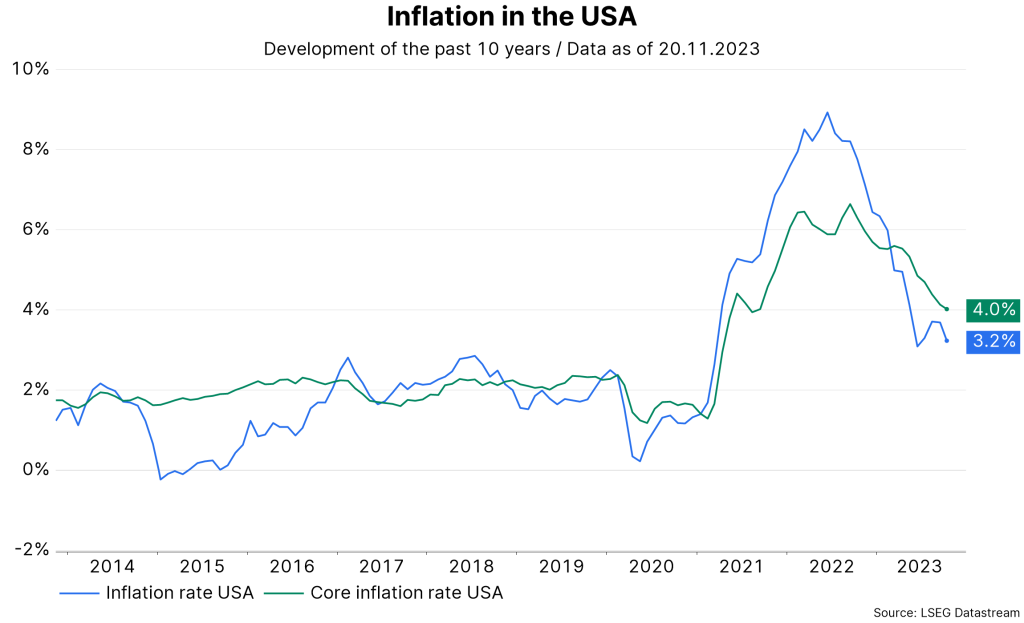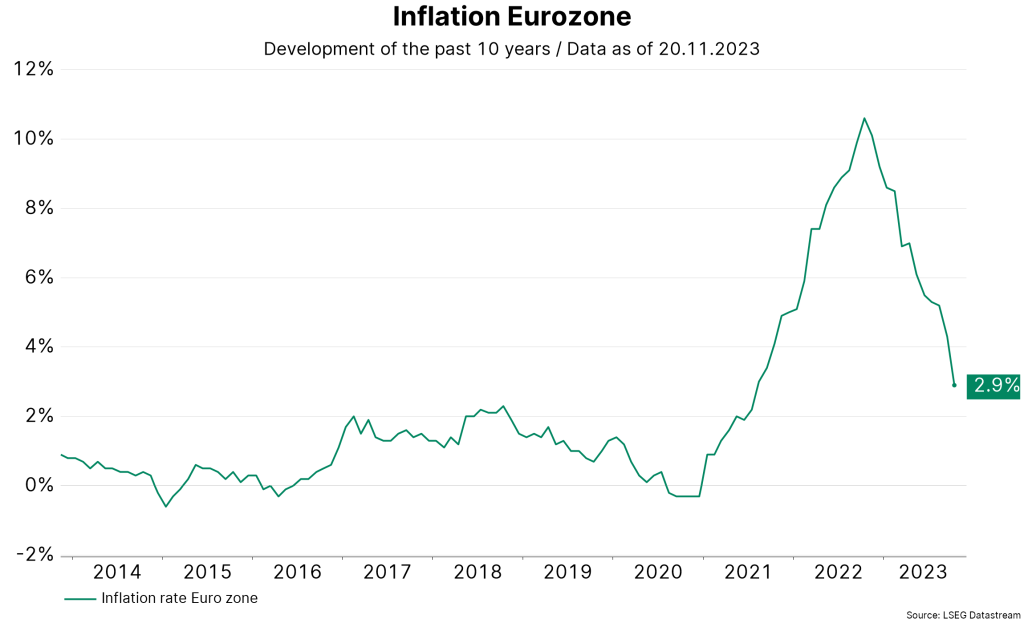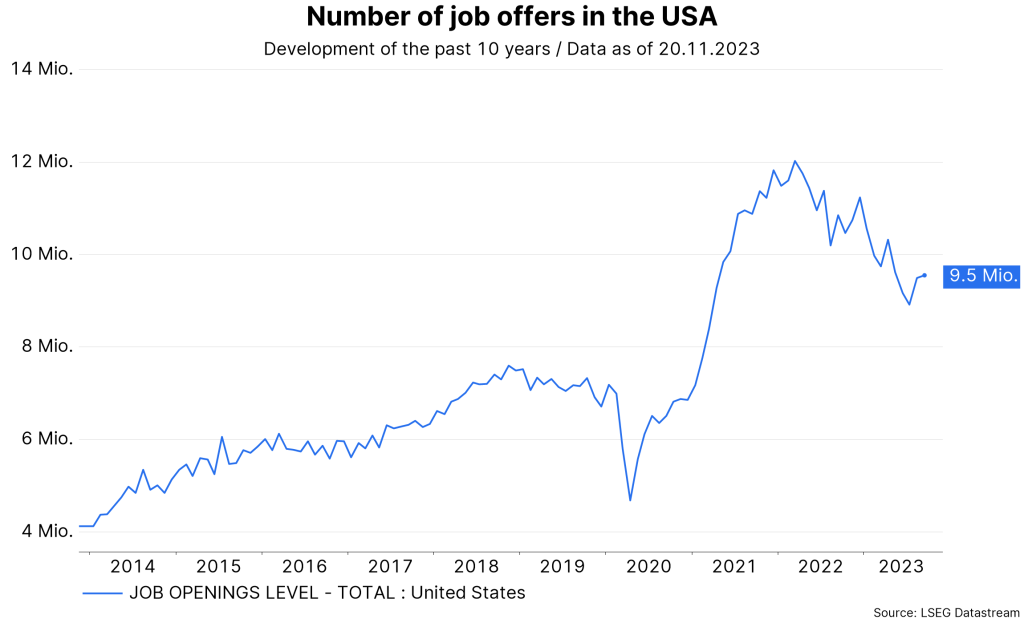
Since the beginning of November, both risky security classes such as equities and credit-safe government bonds have recorded price increases. The US dollar, which is said to be an anti-cyclical currency, and the price of oil have thus fallen.
The market appears to be increasingly pricing in a so-called “soft” landing for the economy. The probability of this actually increased over the course of the year. Nevertheless, the economic data published in recent weeks and months does not contradict the “hard” landing scenario either.
Falling inflationary pressure
Last week, the most important economic report was consumer price inflation for the month of October for the USA. Compared to the previous month, prices remained unchanged, mainly because energy prices fell (-2.5% p.m.). Year-on-year inflation fell from 3.7% to 3.2%.
Most importantly, the various measures of underlying inflation showed a month-on-month decline in inflation. The traditional core rate, i.e. the overall figure excluding the volatile food and energy components, amounted to 0.2% p.m. after 0.3% p.m. in the previous month. Year-on-year inflation fell from 4.1% to 4.0%.

Note: Past performance is not a reliable indicator for future performance of an investment.
Slowly falling inflation, also known as disinflation, can also be seen in many other countries. In the eurozone, consumer price inflation fell from 4.3% in September to 2.9% in October, while the core rate fell from 4.5% to 4.2%. In the OECD area as a whole, inflation has fallen from its high in October 2022 (10.7%) to 6.2% (in September 2023). Overall, inflation rates are trending downwards, but the levels are still too high.

Note: Past performance is not a reliable indicator for future performance of an investment.
Slowly declining demand on the labor market
In addition to falling inflation, the second important development at the macroeconomic level is a slow weakening of the still very tight labor market. Unemployment rates remain at a very low level. In September, the unemployment rate for the entire OECD area was just 4.8%. This is very close to the cyclical low of June.
However, the number of job vacancies is trending downwards in many countries. In the USA, job vacancies have fallen from around 12 million (March 2022) to 9.5 million (September 2023). A similar trend can be observed in Germany (May 2022: 870.000, September 2023: 731.000). To date, the widely expected decline in demand on the labor market has therefore not taken place via a significant increase in the unemployment rate, but primarily via a decline in job vacancies.

Note: Past performance is not a reliable indicator for future performance of an investment.
Trend growth
Against the backdrop of the sharp and rapid increases in key interest rates, economic growth has remained surprisingly strong. In fact, central banks raised the average key interest rate in the OECD area from 0.5% at the beginning of 2022 to 5.7% in September 2023.
The significant tightening of the monetary policy environment had led to fears that economic activity could be severely dampened with an uncertain time lag (falling gross domestic product, significantly rising unemployment rate). However, real gross domestic product grew by 0.5% from the first to the second quarter. This may not sound like much, but it represents an annualized figure of 2% and is actually in line with the long-term average (since 2000).
The strong growth in the USA in the third quarter (4.9% annualized) may even have boosted OECD growth, although both the eurozone (-0.2%) and Japan (-2.1%) are showing signs of contraction. Historically, restrictive monetary policies will significantly dampen economic growth. However, this is “merely” a statistical view. The most important argument for avoiding a “hard” landing is that the continuation of the falling inflation trend would cause real incomes to rise and central banks would soon cut key interest rates.
Resilient financial system
Not only has there been a positive surprise in terms of growth, but the indicators for the state of the financial markets also show surprising resilience. The fear was that the rapid increases in key interest rates could lead to liquidity crises and bankruptcies. However, the previous liquidity crises (UK pension funds, US banks) were quickly digested. The various indicators on financial conditions are currently at an average level.
Conclusion: “Soft” landing not yet clear
Before the description of the economic environment sounds too positive. Inflation is still too high. For this reason, central banks will continue to pursue a restrictive policy. However, because inflation is trending downwards and monetary policy only affects economic activity with an uncertain time lag, the central banks have now adopted a wait-and-see stance.
However, this is not a pivot towards an easing of monetary policy. The central banks want to avoid the mistakes of the 1970s. Back then, key interest rates were too low and key interest rates were cut too early. What remains: Falling inflation is encouraging, but a continuation of this trend is needed for a “soft” landing for the economy. However, this is by no means clear.
For a glossary of technical terms, please visit this link: Fund Glossary | Erste Asset Management
Legal note:
Prognoses are no reliable indicator for future performance.
Legal disclaimer
This document is an advertisement. Unless indicated otherwise, source: Erste Asset Management GmbH. The language of communication of the sales offices is German and the languages of communication of the Management Company also include English.
The prospectus for UCITS funds (including any amendments) is prepared and published in accordance with the provisions of the InvFG 2011 as amended. Information for Investors pursuant to § 21 AIFMG is prepared for the alternative investment funds (AIF) administered by Erste Asset Management GmbH pursuant to the provisions of the AIFMG in conjunction with the InvFG 2011.
The currently valid versions of the prospectus, the Information for Investors pursuant to § 21 AIFMG, and the key information document can be found on the website www.erste-am.com under “Mandatory publications” and can be obtained free of charge by interested investors at the offices of the Management Company and at the offices of the depositary bank. The exact date of the most recent publication of the prospectus, the languages in which the fund prospectus or the Information for Investors pursuant to Art 21 AIFMG and the key information document are available, and any other locations where the documents can be obtained are indicated on the website www.erste-am.com. A summary of the investor rights is available in German and English on the website www.erste-am.com/investor-rights and can also be obtained from the Management Company.
The Management Company can decide to suspend the provisions it has taken for the sale of unit certificates in other countries in accordance with the regulatory requirements.
Note: You are about to purchase a product that may be difficult to understand. We recommend that you read the indicated fund documents before making an investment decision. In addition to the locations listed above, you can obtain these documents free of charge at the offices of the referring Sparkassen bank and the offices of Erste Bank der oesterreichischen Sparkassen AG. You can also access these documents electronically at www.erste-am.com.
Our analyses and conclusions are general in nature and do not take into account the individual characteristics of our investors in terms of earnings, taxation, experience and knowledge, investment objective, financial position, capacity for loss, and risk tolerance. Past performance is not a reliable indicator of the future performance of a fund.
Please note: Investments in securities entail risks in addition to the opportunities presented here. The value of units and their earnings can rise and fall. Changes in exchange rates can also have a positive or negative effect on the value of an investment. For this reason, you may receive less than your originally invested amount when you redeem your units. Persons who are interested in purchasing units in investment funds are advised to read the current fund prospectus(es) and the Information for Investors pursuant to § 21 AIFMG, especially the risk notices they contain, before making an investment decision. If the fund currency is different than the investor’s home currency, changes in the relevant exchange rate can positively or negatively influence the value of the investment and the amount of the costs associated with the fund in the home currency.
We are not permitted to directly or indirectly offer, sell, transfer, or deliver this financial product to natural or legal persons whose place of residence or domicile is located in a country where this is legally prohibited. In this case, we may not provide any product information, either.
Please consult the corresponding information in the fund prospectus and the Information for Investors pursuant to § 21 AIFMG for restrictions on the sale of the fund to American or Russian citizens.
It is expressly noted that this communication does not provide any investment recommendations, but only expresses our current market assessment. Thus, this communication is not a substitute for investment advice.
This document does not represent a sales activity of the Management Company and therefore may not be construed as an offer for the purchase or sale of financial or investment instruments.
Erste Asset Management GmbH is affiliated with the Erste Bank and austrian Sparkassen banks.
Please also read the “Information about us and our securities services” published by your bank.

